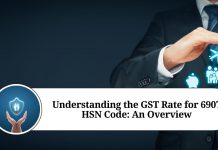Understanding HSN Code of Rice
Harmonized System of Nomenclature (HSN) code is a globally accepted system for classifying goods and products in international trade. HSN code helps in identifying the product and determining the applicable taxes, duties, and regulations for the same. In this blog, we will discuss the HSN code of rice, which is one of the most widely traded commodities across the globe.
What is HSN Code of Rice?
The HSN code of rice is 1006. Rice falls under chapter 10 of the HSN classification, which deals with cereals. The HSN code of rice is used to classify the different types of rice, including brown rice, white rice, and parboiled rice.
Classification of Rice under HSN Code
Rice is classified under HSN code 1006 based on various factors such as grain length, color, and texture. Here are the different types of rice and their corresponding HSN codes:
- Basmati Rice: HSN code – 1006 10 10
- Non-Basmati Rice: HSN code – 1006 10 90
- Paddy Rice: HSN code – 1006 20 00
- Broken Rice: HSN code – 1006 30 10
- Husked Rice: HSN code – 1006 30 20
- Semi-Milled or Wholly Milled Rice: HSN code – 1006 30 30
- Rice Flour and Rice Bran: HSN code – 1102 90 10
Importance of HSN Code of Rice
The HSN code of rice is essential for businesses engaged in the trade of rice. It helps in determining the applicable customs duties, taxes, and regulations for the import and export of rice. Moreover, the HSN code of rice is also used for statistical purposes by government agencies and international organizations.
HSN code of rice plays a critical role in the international trade of rice. It is an integral part of the Customs Tariff, and businesses involved in rice trade must know the correct HSN code of rice to avoid any confusion or mistakes.
The classification of rice under different HSN codes based on their type, texture, and grain length is crucial for customs and other authorities to determine the applicable duty rates, taxes, and regulations for each type of rice. For instance, the duty rates for Basmati rice are different from that of Non-Basmati rice.
Apart from trade and customs purposes, the HSN code of rice is also used for statistical analysis by government agencies and international organizations to track and analyze the trade and consumption patterns of rice globally. This information can be used to identify trends, forecast demand, and develop policies to promote sustainable rice production and trade.
Furthermore, the HSN code of rice is also helpful for consumers as it provides them with information about the type of rice they are purchasing. Consumers can use this information to make informed choices based on their dietary preferences, cooking requirements, and taste preferences.
Conclusion
In conclusion, the HSN code of rice is a crucial classification system used in international trade, customs, and statistical analysis. Businesses, customs authorities, and consumers must be aware of the correct HSN code of rice to ensure compliance with relevant regulations, avoid penalties and fines, and make informed choices about rice consumption and trade.
Read more useful content:
Frequently Asked Questions (FAQs)
What is HSN code of rice?
HSN code of rice is 1006. It is used to classify different types of rice based on grain length, color, and texture.
What are the different types of rice classified under HSN code?
Basmati Rice, Non-Basmati Rice, Paddy Rice, Broken Rice, Husked Rice, Semi-Milled or Wholly Milled Rice, Rice Flour and Rice Bran are the different types of rice classified under HSN code.
What is the importance of HSN code of rice?
HSN code of rice helps in identifying the product and determining the applicable taxes, duties, and regulations for the same. It is crucial for businesses engaged in the trade of rice and also used for statistical analysis by government agencies and international organizations.
How does the HSN code of rice help in international trade?
HSN code of rice helps in determining the applicable customs duties, taxes, and regulations for the import and export of rice. It helps businesses comply with relevant regulations and avoid any penalties or fines.
Is the HSN code of rice the same across all countries?
The first six digits of the HSN code are uniform across all countries, but some countries may have additional digits to further classify products.
Can the HSN code of rice change over time?
Yes, the HSN code of rice can change over time based on changes in the classification system or updates in regulations.
Are there any exemptions or special provisions for HSN code of rice?
There are exemptions and special provisions for HSN code of rice, depending on the country’s policies and regulations.
How can businesses determine the correct HSN code of rice for their products?
Businesses can refer to the HSN code list published by the respective customs authority or seek guidance from an expert or professional in the field.
Is the HSN code of rice applicable for both import and export?
Yes, the HSN code of rice is applicable for both import and export.
Can consumers benefit from knowing the HSN code of rice?
Yes, consumers can benefit from knowing the HSN code of rice as it provides them with information about the type of rice they are purchasing and helps them make informed choices based on their dietary preferences, cooking requirements, and taste preferences.




















